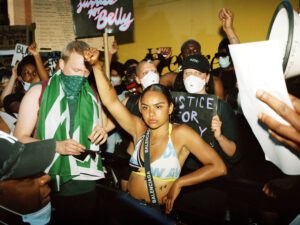Salt extraction sites. Marble quarries. Dry lake beds. Burning gas wells. These are the backdrops for Liz Miller Kovacs, a photographer and avid traveller interested in the relationship between body and landscape. Kovacs visits “scars of the Earth” all around the world, navigating sites that have been excavated, depleted, polluted and often hidden from public view. These places are subject to a strange phenomenon: remaining beautiful and awe-inspiring, despite the damage they wreak.


“You might think the photo was taken with a snow-capped mountain in the background,” Kovacs says of Monte Kali Apparition (2022), a picture staged next to a 530 metre-high pile of mining waste. Here, the sublime peaks of Romantic painting are substituted with industrial byproducts. Elsewhere, salt formations resemble icebergs and enticing bodies of water brim with acid and toxic heavy metals. Each photograph in Supernatural features a draped figure – Kovacs herself – recalling “Venuses, effigies and fertility figures in archaeological sites and ancient art.” Recent works include Ijen Venus (2024), taken at an East Java volcano.


Sulfuric fog rises up, like dry ice on stage, from a place where miners transport up to 100 kilograms of sulfur on their shoulders every day. Odalisques, sirens and surreal apparitions are used here as a callback to the iconography and objectification of the female form across art history. This opens an interesting avenue of enquiry where we’re asked to consider the representation of women in such spaces – both in front of and behind the camera lens. At a time when Google searches for “famous landscape photographers” still yield a list of predominantly male artists, Kovacs redresses the balance.


miller-kovacs.art | @miller.kovacs
All images courtesy Liz Miller Kovacs, from the Supernatural (2020 – present) series.





